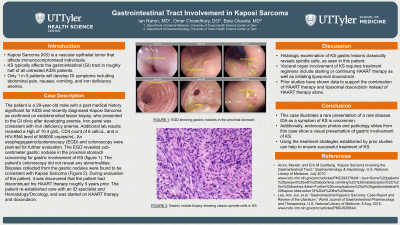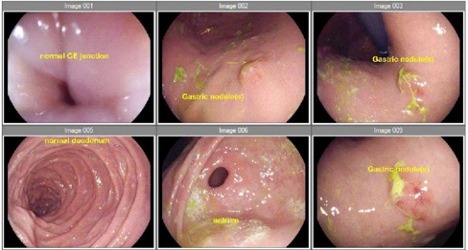Sunday Poster Session
Category: GI Bleeding
P0615 - Gastrointestinal Tract Involvement in Kaposi Sarcoma
Sunday, October 22, 2023
3:30 PM - 7:00 PM PT
Location: Exhibit Hall

Has Audio

Ian Naron, MD
University of Texas Health Science Center at Tyler
Tyler, TX
Presenting Author(s)
Ian Naron, MD1, Omer Chowdhury, DO1, Bolarinwa F. Olusola, MD2
1University of Texas Health Science Center at Tyler, Tyler, TX; 2University of Texas Health East Texas Physicians, Tyler, TX
Introduction: Kaposi Sarcoma (KS) is a vascular epithelial tumor that affects immunocompromised individuals. Patients who develop KS are typically found to be Human Herpesvirus-8 (HHV8) positive. KS typically affects the gastrointestinal (GI) tract in roughly half of all untreated AIDS patients. However, only 1 in 5 patients will develop GI symptoms including abdominal pain, nausea, vomiting, and iron deficiency anemia. We present a case of a young patient who was non-compliant with HAART therapy presenting to the GI clinic with new onset anemia.
Case Description/Methods: Patient is a 29-year-old male with a past medical history significant for AIDS and recently diagnosed Kaposi Sarcoma as confirmed on endobronchial lesion biopsy, who presented to the GI clinic after developing anemia. Iron panel was consistent with iron deficiency anemia. Additional lab results revealed a Hgb of 10.4 g/dL, CD4 count of 6 cell/uL, and an HIV-RNA level of 568000 copies/mL. An esophagogastroduodenoscopy (EGD) and colonoscopy were planned for further evaluation. The EGD revealed sub-centimeter gastric nodules in the proximal stomach concerning for gastric involvement of KS (figure 1). The patient’s colonoscopy did not reveal any abnormalities. Biopsies collected from the gastric nodules were found to be consistent with Kaposi Sarcoma. During evaluation of the patient, it was discovered that the patient had discontinued his HAART therapy roughly 5 years prior. The patient re-established care with an ID specialist and Hematology/Oncology, and was started on HAART therapy and doxorubicin.
Discussion: This case illustrates the classic manifestations of IDA in patients with Kaposi Sarcoma as well as the associated endoscopic findings of gastric nodular lesions. KS GI tract lesions can be variable in appearance and often cannot be grossly differentiated from other common GI tract pathologies. Therefore, histopathologic confirmation from tissue biopsy is important. Histologic examination of KS gastric lesions classically reveals spindle cells, as seen in this patient. Treatment regimens include starting or continuing HAART therapy as well as initiating liposomal doxorubicin. A baseline transthoracic echocardiogram should be obtained prior to starting doxorubicin. Prior studies have shown data to support the combination of HAART therapy and liposomal doxorubicin instead of HAART therapy alone.

Disclosures:
Ian Naron, MD1, Omer Chowdhury, DO1, Bolarinwa F. Olusola, MD2. P0615 - Gastrointestinal Tract Involvement in Kaposi Sarcoma, ACG 2023 Annual Scientific Meeting Abstracts. Vancouver, BC, Canada: American College of Gastroenterology.
1University of Texas Health Science Center at Tyler, Tyler, TX; 2University of Texas Health East Texas Physicians, Tyler, TX
Introduction: Kaposi Sarcoma (KS) is a vascular epithelial tumor that affects immunocompromised individuals. Patients who develop KS are typically found to be Human Herpesvirus-8 (HHV8) positive. KS typically affects the gastrointestinal (GI) tract in roughly half of all untreated AIDS patients. However, only 1 in 5 patients will develop GI symptoms including abdominal pain, nausea, vomiting, and iron deficiency anemia. We present a case of a young patient who was non-compliant with HAART therapy presenting to the GI clinic with new onset anemia.
Case Description/Methods: Patient is a 29-year-old male with a past medical history significant for AIDS and recently diagnosed Kaposi Sarcoma as confirmed on endobronchial lesion biopsy, who presented to the GI clinic after developing anemia. Iron panel was consistent with iron deficiency anemia. Additional lab results revealed a Hgb of 10.4 g/dL, CD4 count of 6 cell/uL, and an HIV-RNA level of 568000 copies/mL. An esophagogastroduodenoscopy (EGD) and colonoscopy were planned for further evaluation. The EGD revealed sub-centimeter gastric nodules in the proximal stomach concerning for gastric involvement of KS (figure 1). The patient’s colonoscopy did not reveal any abnormalities. Biopsies collected from the gastric nodules were found to be consistent with Kaposi Sarcoma. During evaluation of the patient, it was discovered that the patient had discontinued his HAART therapy roughly 5 years prior. The patient re-established care with an ID specialist and Hematology/Oncology, and was started on HAART therapy and doxorubicin.
Discussion: This case illustrates the classic manifestations of IDA in patients with Kaposi Sarcoma as well as the associated endoscopic findings of gastric nodular lesions. KS GI tract lesions can be variable in appearance and often cannot be grossly differentiated from other common GI tract pathologies. Therefore, histopathologic confirmation from tissue biopsy is important. Histologic examination of KS gastric lesions classically reveals spindle cells, as seen in this patient. Treatment regimens include starting or continuing HAART therapy as well as initiating liposomal doxorubicin. A baseline transthoracic echocardiogram should be obtained prior to starting doxorubicin. Prior studies have shown data to support the combination of HAART therapy and liposomal doxorubicin instead of HAART therapy alone.

Figure: Figure 1: EGD showing gastric nodules in the proximal stomach.
Disclosures:
Ian Naron indicated no relevant financial relationships.
Omer Chowdhury indicated no relevant financial relationships.
Bolarinwa Olusola indicated no relevant financial relationships.
Ian Naron, MD1, Omer Chowdhury, DO1, Bolarinwa F. Olusola, MD2. P0615 - Gastrointestinal Tract Involvement in Kaposi Sarcoma, ACG 2023 Annual Scientific Meeting Abstracts. Vancouver, BC, Canada: American College of Gastroenterology.
